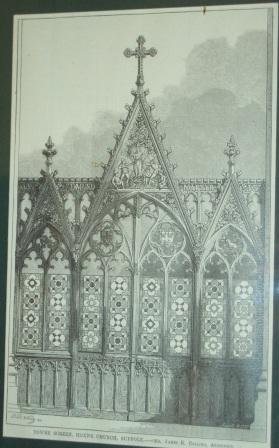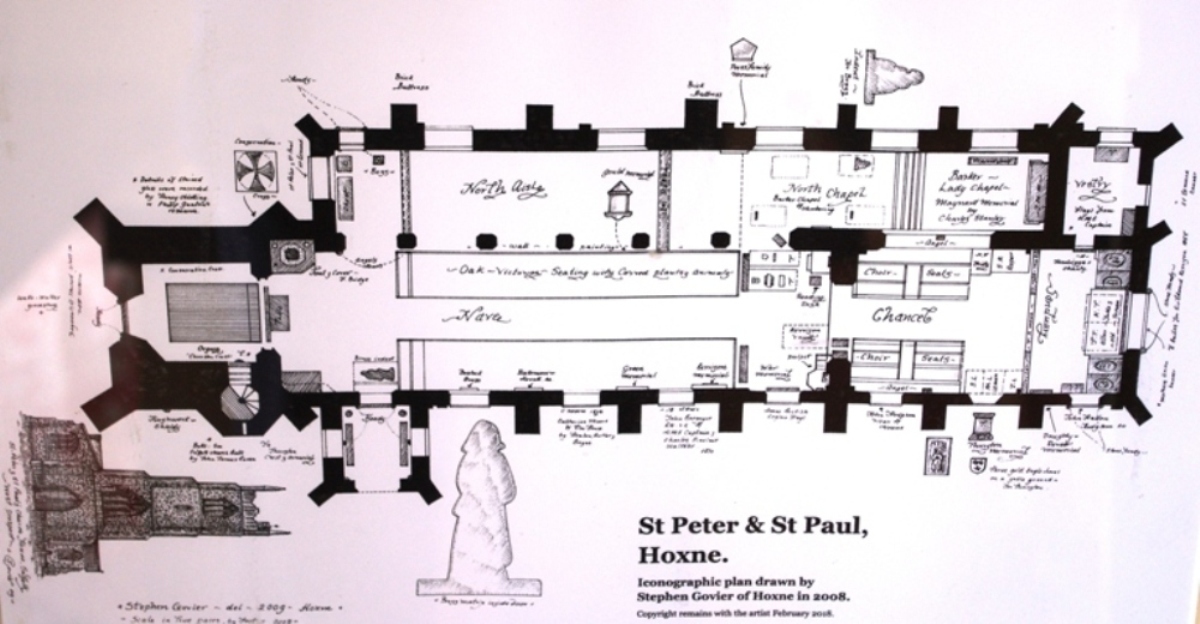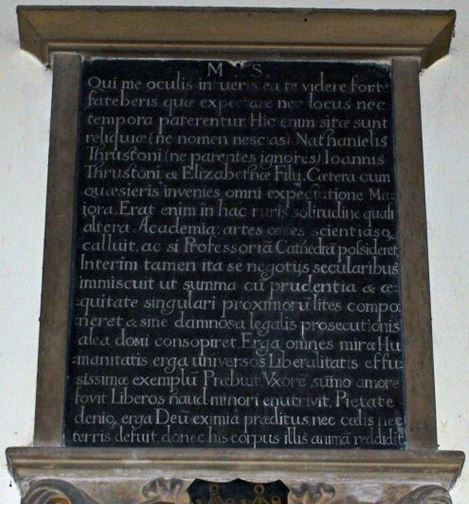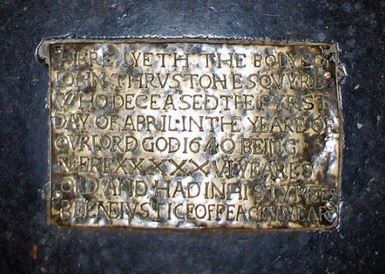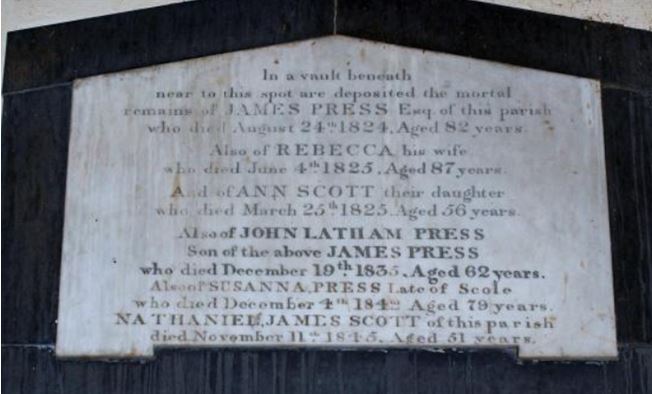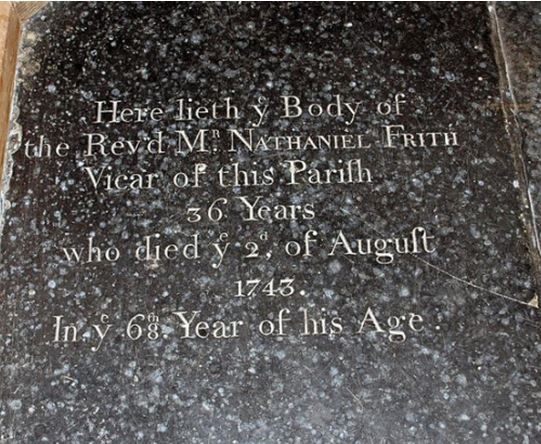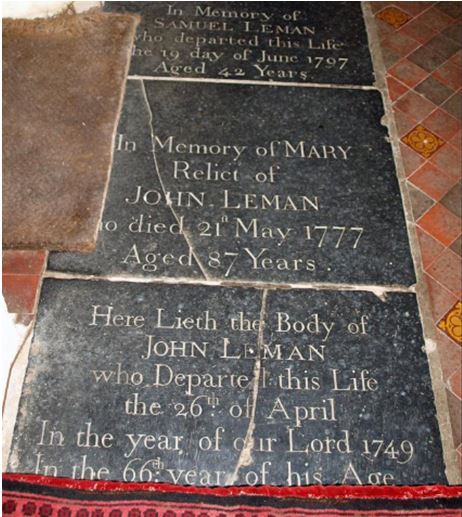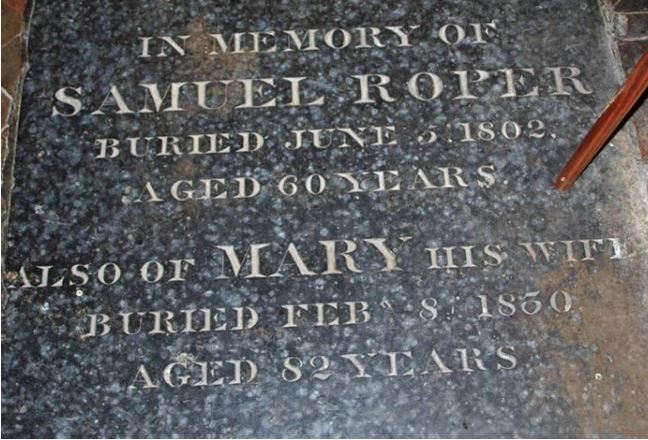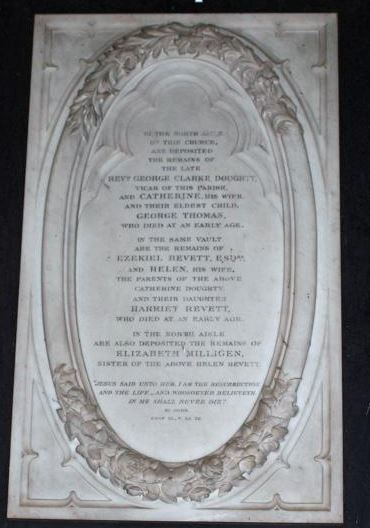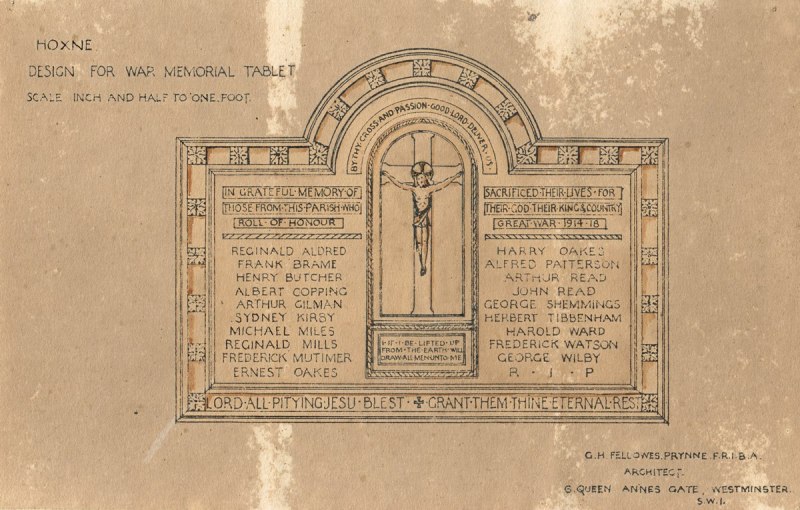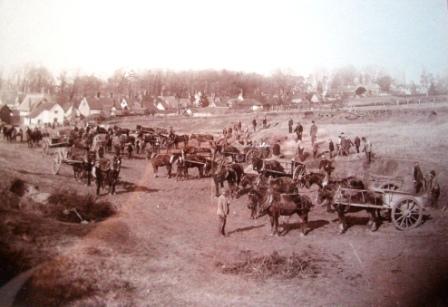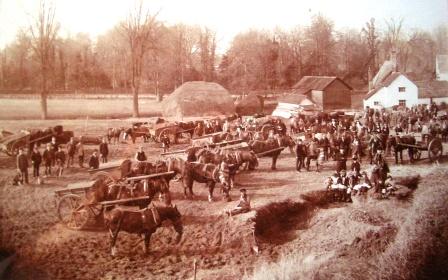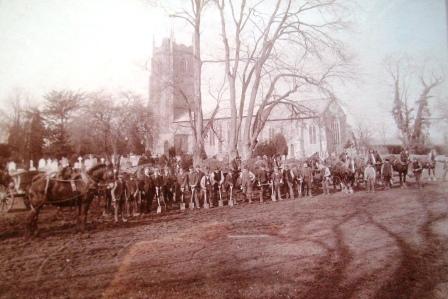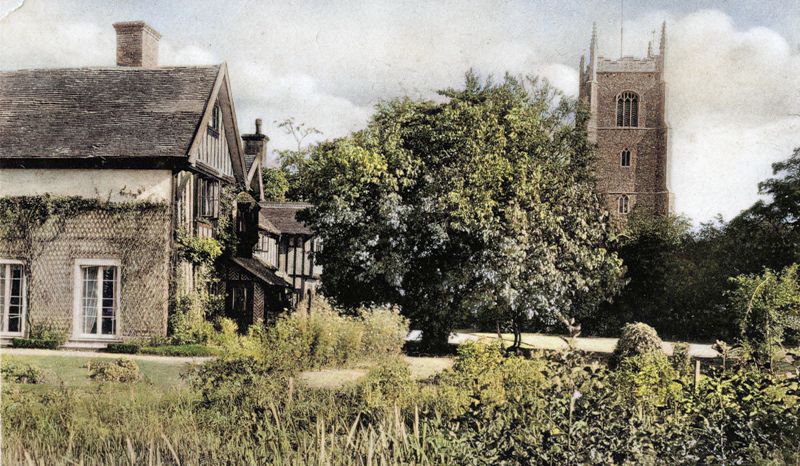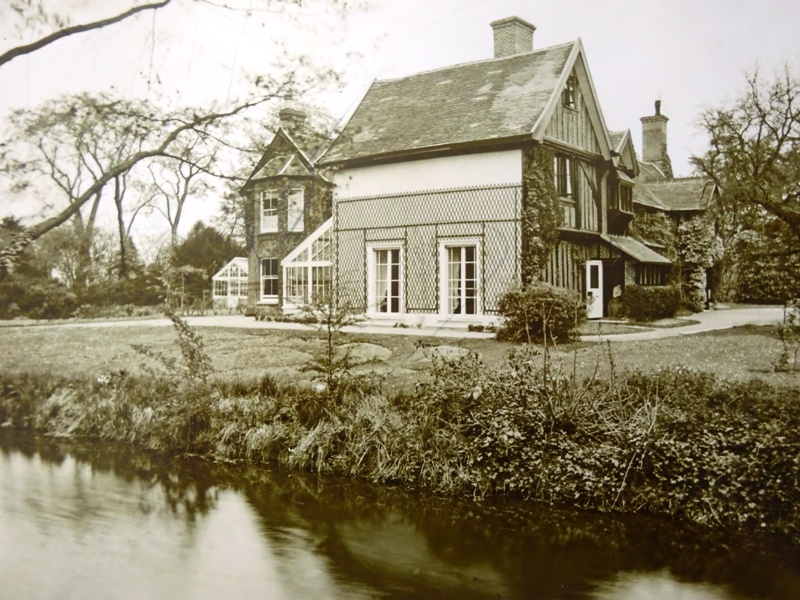
The Church of St. Peter and St. Paul with St. Edmund in Hoxne
As part of a series of celebrations recognising the patron saint of East Anglia's life, Hoxne's Parish Church changed its name from the 'Church of St. Peter and St. Paul' to the 'Church of St. Peter and St. Paul with St. Edmund' on November 20th 2020 - exactly 1150 years after the death of St. Edmund. The celebration began with a blessing by the Bishop of Dunwich, the Right Reverend Dr. Mike Harrison, in a service held at the church at 7pm on Wednesday, 20th November.Click on the links below for more details.
Church Architecture and decorations
Church Fittings and Possessions
Bequests to the Church and Burial Requests in Wills
Memorials and Inscriptions inside the Church
The Churchyard and Gravestones
Vicars and biographies of some
Vestry Meetings and Churchwardens
Church Architecture, Decorations and Font
The Church is built in the perpendicular style but it is believed that there were several other church buildings on this site prior to the current one which is Grade 1 listed. Follow the link below for the listing which notes its architectural details.
Listing→
The North Chapel
Curiously the North Chapel of the church seems to have belonged to the Barker family, then the Freres and finally the Maynards.
In 1475 Robert Barker left a close called Ealstongs, and two acres of land in Low close, and one piece of land lying in the close of John Doo, for ever to the inhabitants of Hoxne, to pay the King's fifteenth, or the taske (tax) when it occurs; and also wills to have a chapel of St Mary the Virgin built of his goods. (Reg. Gelour, 198.) Robert Barker was vicar of Hoxne from 1461 to 1475.
Henry Chitting on his visitaion between 1606 and 1613 records:
In a chapel on the north side on a gravestone in brass 'Orate pro a'i'a Rob'ti Barker qui hanc capellam fieri fecit'
The Barker inscription was noted as an indent on the same slab
as a brass inscription for Thomas Barker, d. 1626, now lost, in the north chapel.
From Hoxne and South Elmham Visitation Book in 1670: To repair the North Isle of the Chancel in ye Glazing which belong to ye family Barker and their relatives.
Edward Steele in 1712 records:
The north chancel (separated from the other by an ancient screen, the enclosure of a large arch) is appropriated to the sole use of the family of Barkers. In it lie only two grave stones. The one on the south side inscribed;
'Here lyeth Mr Bennet Barker, who was
twice Alderman of Bury St. Edmunds,
and departed this life on the 25th January 1632.'
The other adjoining it has fixed on it a small brass plate on which is written:
'Here lyeth the body of Tho. Barker, Gent.
who departed this life on the 2nd January 1626
and was buried here the 5th day following.'
This would have been 1627 in todays dates and 1632 would be 1633. Thomas lived in Chickering but died in Bury St. Edmunds.
However in the papers of David Elisha Davy the North Aisle seems to belong to Edward Frere of Thwaite. He appears to give it to Thomas Maynard on th 19th September 1734.
I Edward Frere of Thwaite Esq. do give and grant to Thomas Maynard of Hoxne Esq. and to his heirs, all that Isle on the North side of the Chancele belonging to the church of Hoxne aforesaid of or belonging to me the said Edward Frere containing in length within the walls from E. to W. 26 feet or thereabouts and in breadth from N. to S. 12 feet or thereabouts and all my Estate and Interest therein. In witness whereof I have to - E. Frere
Sealed and delivered in the presence of
Thomas Betts
Thomas Deye
It was Edward Frere (1680-1766) who purchased the Hoxne estate of Sir Charles Vernon. This seems to have included Chickering Corner Farm which is believed to have been, previously, the home of the Barker family.
Renovations and Repairs
From Hoxne and South Elmham Visitation Book:
1670
Hoxne : Mr Ed. Willan Vicar
Sam. Leman. John Annis. (Churchwardens)
To repair the church windows where they are decayed in ye Glazing work.
To repair the North Isle of the Chancel in ye Glazing which belong to ye family Barker and their relatives.
1686
Hoxne: Ed. Willan Vicar
Wm. Jasper. Andrew Foulger. (Churchwardens)
To new fence in the churchyard where it wants.
To provide the 39 Articles and Book of Canons.
There hath been a Vestry which is very ruinous and decayed.
1799
A faculty was granted to Thomas Maynard giving him permission to erect two pews in the chancel of Hoxne Church. One pew to be 9 feet long, 6 feet 6 inches wide and 6 feet high, the other 9 feet long, 4 feet 2 inches wide and 6 feet high. The pews were for exclusive use of the Maynards 'to sit, kneel and stand to hear Divine service therein'.
1848 At a Vestry meeting thanks were given to Sir Edward and Lady Kerrison for their great kindness and liberality in restoring the pinnacles of the church tower and in making several other improvements in the church.
1851 was the start of a period of rebuilding the church.
| Year | £ | s. | d. | |
|---|---|---|---|---|
| 1851 | Restoration of 3 windows, buttresses, plinth etc. for south side of the church as paid to Mr. Farrow, glazier. | 44 | 16 | 9 |
| 1854 | Building the vestry and repairing the church as paid to Mr Woollard, builder. | 75 | 13 | 6 |
| 1856 | Repairing the church as paid to Mr Woollard. | 15 | 16 | 9 |
| 1860 | New door and restoring south entrance paid to Godbold and Son. | 21 | 19 | 6 |
| 1863 | Restoring the doorway paid to Mr. Vine - Stone Mason. | 5 | 17 | 6 |
| 1864 | Mr. Vine - Stone Mason. | 13 | 0 | 0 |
| 1867 | Church stove pipe etc. paid to W.T. Gidney. | 25 | 4 | 9 |
| 1867 | Repairing Bell wheels as paid to George Day, Wheelwright, Smith and Bell Hanger of Eye. | 10 | 6 | |
| 1870 | Benching the church as paid to R. Cornish of Aylsham. | 145 | 0 | 0 |
| 1871 | Altar rails as paid to George Day. | 3 | 18 | 4 |
| 1873 | Benching rest of the church paid to R. Cornish. | 5 | 0 | 0 |
| 1874 | Repairing roof paid to H. Burrows. | 14 | 4 | 0 |
| 1875 | Rehanging bells paid to George Day | 25 | 0 | 0 |
| 1880 | Benching the Chancel as paid to Cornish and Gaymer | 22 | 0 | 0 |
Some of this expenditure was paid for by selling off surplus or obsolete church possessions.
| Year | £ | s. | d. | |
|---|---|---|---|---|
| 1858 | Sale of old worn out Sacremental Cup. | 1 | 11 | 0 |
| 1858 | Cash for old Pewter Tankard. | 1 | 2 | |
| 1862 | By old stove and lead. | 14 | 6 |
In 1853 Mr Woollard was paid £75 13s 6d to build the Vestry and repair the church.
The roof was repaired in the early 1950s.
Wall Paintings
Wall paintings were discovered when cleaning the walls in 1835 as reported in The Ipswich Journal of 11th April 1835. They were descibed as:-
'one representing David on the field of battle with Goliath, one thought to be St. Paul in the stocks at Philippi and there was also the Crucifixion and the Resurrection from the Dead, etc.' There were also several inscriptions.
They were said to be about 10 feet high and twelve feet wide. There were also several inscriptions. These were all probably on the South wall but are no longer visible, probably having been whitewashed over.
More paintings were discovered when cleaning the walls in 1926. These are on the north side of the nave, above the arches. They date from about the second half of the fourteenth century and restored by Ernest William Tristram (1882 -1852). Ernest Tristram made some watercolour copies of the Seven Deadly Sins and the Seven Acts of Mercy which are now housed in the Victoria and Albert Museum. He also made a copy of painted decoration in roof of nave. The wall paintings are about 10 feet high and 12 feet wide. The subjects depicted are as follows:
Saint Christopher
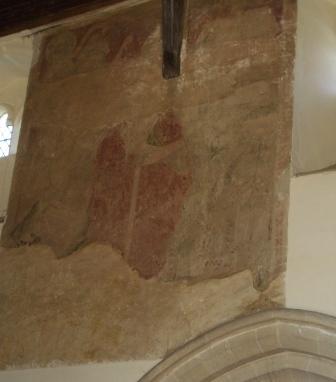
Located between the first and second windows is Saint Christopher bearing the Holy Child on his right shoulder and holding the staff which grew into a tree, which divides the picture down the centre. On the right is the bank of a river and in the top corner is the hermitage and near the bank stands the hermit.
The Seven Deadly Sins
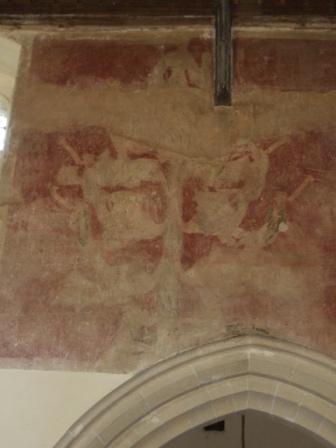
Located between the second and third windows a tree is depicted in the centre, at the top of which is the figure of Pride wearing a tunic belted at the waist, wide sleevesand a scalloped collar. In her right hand is a sceptre and her left a mirror. From the tree trunk spring six dragons in whose mouths are allegorical figures representing the other sins. The two fother figures probably representing Envy and Gluttony are missing. Covetonsness is represented by a figue holding a bag in one hand and taking coins from a box with the other.Other figures represent Lust, Anger and Sloth. At the base of the tree are two devils with horns and tails sawing down the trunk of the tree with a two-handed saw.
Acts of Mercy

Located between the third and fourth windows are the Seven Corporal Acts of Mercy represented in two tiers. On the upper tier are pictured 'Clothing the Naked', 'Giving drink to the Thirsty' and 'Visiting the Imprisoned'. On the lower tier are pictured 'Feeding the Hungry', 'Harbouring the Harbourless', Visiting the Sick' and 'Burying the Dead'. The latter being damaged.
The Last Judgement
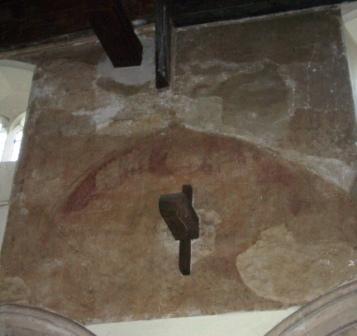
Located between the fourth and fifth windows is, indistinctly, a painted arch resembling a rainbow, with probably the figure of Christ seated at the top with faintly visible angels on either side holding symbols of the Passion. Just beneath the centre of the rainbow is the Firmament and to the right and left are figures, possibly of the Apostles. Below are depicted the Blessed and The Damned and between the St. Michael weighing souls. At the base, on the right, open graves appear to be representing the resurection and to the right of these Hell's mouth.
H. Munro Cantley records in his 'Suffolk Churches and their Treasures', published in 1937, 'in the middle of the cornice on the south side painted angels remain with black and white barber's pole ornament above'. This was rediscovered in 1965.
Windows
Henry Chitting's (1580-1638) Suffolk Visitation of Churches records the church windows and Edward Steele records the south and east windows similarily on his visit in 1712:-
East window in the ChancelSouth window there
- France and England quarterly.
- Episcopalis Norw., azure 3 miters or.
- St. George, argent a crosse gules.
On the west window of the steple
- Herbert Episcopus Norw., argent a bull and a border ingr. sable armed or and the border beysanted.
- Goldwell Episcopus Norw., parti per pale B. a cheif or over both a lion rampant argent billeted sable.
- Caly, checky azure and gules over all a bend ermine.
west window of the church
- Popes, azure 2 beyes crost in saltier argent.
- The Bishoprick of Norwich,- azure 3 miters.
- Abbas Sancti Edmundi, azure 3 crownes or.
- Goldwell Episcopus.
Notes:-
James Goldwell was Bishop of Norwich 1472-99.
Herbert de Losinga was Bishop of Norwich 1094/5-1119.(Bishop of Thetford 1091- 1094/5 - the See being moved from Thetford to Norwich).
It is not known what happened to these windows only that the church now has seven stained glass windows dating from 1855 to 1876.

East Window
The East window was commissioned by Sir Edward Clarence Kerrison and signed by E. Baillee of London, 1855. It has 4 compartments - the Transfiguration, Jesus on the Cross, Jesus being taken down from the Cross and the Ascension.
The next window on the right of the sanctuary was made by Heaton, Butler and Bayne in 1868. It pictures the figures of St Matthew and St. Mark in memory of Lt. John Hatton Hodgson R.N., who died aged 22 on 17th February 1868.
The Revd. John Hodgson (vicar of Hoxne for 25 years), who died on 20th October 1868, aged 63, in the next.
In the next window St. Peter and St. Paul are depicted on a oak leaf grid pattern.
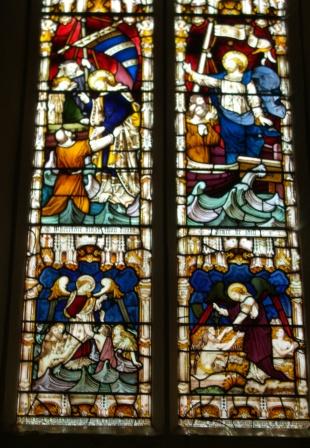
Memorial to Charles Shirley Walker and Hugh Burgoyne
The next being devoted to the memory of Charles Shirley Walker (1870) and Hugh Burgoyne, master of the HMS Captain. This window was probably created by Clayton and Bell. It includes raising the dead and raising the drowned.
Memorial to Catherine Moore
The last window on the south wall is by Heaton, Butler and Bayn of London, 'Suffer little children to come unto me' as a memorial to Catherine Moore of Elm House, Green Street, Hoxne who died 18th January 1876, aged 60 and her 3 grandchildren.

West Window
The window on the West wall of the north aisle features the crossed keys of St. Peter, the crossed swords of St. Paul and the St. Edmund Crown.Graffiti
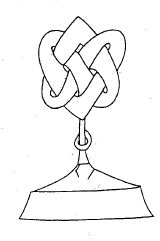
Notarial Sign
A rare graffito in the form of a double-heartshaped endless knot was scratched on the north-east respond (a half-pillar or half-pier attached to a wall to support an arch, especially at the end of an arcade) in the nave of the church. The graffito was originally published by the late Violet Pritchard, who confidently describes it as a design 'peculiar to Saxon art' in her 1967, publication, 'English Medieval Church Graffiti'. However it is believed to be a medieval notarial sign, a mark of attestation penned by a public notary upon all the legal documents he drafted.
Notarial signs were ordinarily based upon a cross, but many were designed upon the basis of a trefoil, hexafoil, octofoil or some form of interlaced pattern. Whatever design was chosen, almost all were depicted as though standing upon a base in the manner of a medieval monstrance.
There is no longer any trace of this sign. It could have been painted over during a restoration, or it is possible that Violet Pritchard was mistaken about the church that she had seen it in?
Font
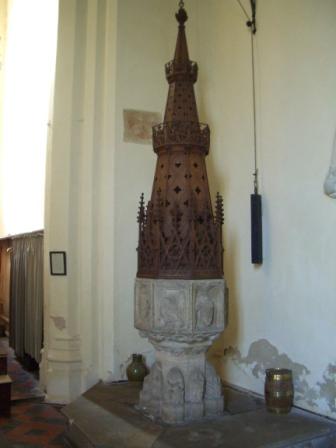
Church Font
The Ipswich Journal of 22nd December 1877 records that a musical evening was arranged to raise funds for the restoration of the font which had become 'dilapidated and defaced and greatly in need of repair'.
As described by Rev. C. R. Manning, when visiting the church in 1888 with members of the Suffolk Institute of Archaeology and Natural History. 'The font is one of a very common East Anglian type, having an octagonal bowl, with four of the sides sculptured with the emblems of the four Evangelists (Saints Matthew, Mark, Luke and John), and the other four with angels bearing shields of arms. The bowl is supported underneath by angels with expanded wings, and the stem has four seated figures round it, and four others, smaller, standing on pedestals. The seated figures wore cowls or tippets, but their heads are broken off; the others, where not mutilated, appear to have high pointed caps or turbans, and wear stoles. Possibly these two sets may represent the four doctors of the church, and the four greater prophets. Of the four shields on the bowl, those on the north and the west faces bear, on the one two keys, and on the other two swords, in saltire, emblems of SS. Peter and Paul, in whose honour the church is dedicated. The shield on the east face has the arms of Bishop Walter Lyhart, of Norwich (1446 to 1472), viz. : Argent, a bull passant sable, within a border of the second bezanty. There appears no indication of a mitre in middle chief of the border, or, which is sometimes found with this bishop's arms ; but the carving is somewhat mutilated.Bishop Lyhart was an eminent church builder who died at his palace at Hoxne on Whit Sunday 1472. So far, then, we may safely bring the date of the restored work here to the 26 years of his episcopate. The other shield on the south face of the font helps us to narrow the time yet more. The arms are those of De la Pole, azure, a fess between three leopards' faces; or : quartering Burghersh, gules, a lion rampant, double-quened, or : and impaling the Royal arms, France and England quarterly, with a label of three points. These are the arms of John de la Pole, second Duke of Suffolk (son of William, fourth Earl, and first Marquess and Duke, beheaded 1450, and of his wife, Elizabeth Plantagenet, sister of Edward IV and Richard III., who was re-instated in his father's honours, and created Duke of Suffolk in 1463. He married the daughter of Richard, Duke of York, before October, 1460, when only eighteen years old. Consequently, the font must have been erected after 1460, and probably after 1463, when his restored honours would enable him to be liberal in church building, and before 1472, when he was made a Knight of the Garter of which there is no sign on the shield. I think we may therefore narrow the date of the font to certainly within the 10 years before 1473, and probably to about 1463 or 1465.'
The mutilation of the figures on the font was the work of William Dowsing when he visited the church in 1644.
William Dowsing was 47 when, in December 1643, he accepted a commission from the Earl of Manchester to remove and destroy high church idolatry from the parish churches in the Eastern Association. What many Puritans regarded as the dangerously 'Popish' stained glass, altar rails, statues, and effigies in England's churches that had escaped the Reformation the century before.
Dowsing notes in his journal:-
HOXNE, Aug. 30th. 2 Stone Crosses on Church, and Chancel; Peter with his Fish; and a Cross in a Glass Window, and 4 superstitious ones. The Virgin Mary with Christ in her Arms; and Cherubims Wings on the Font. Many more were broken down afore.
The latter part of his note is explained by the entry in the churchwarden's accounts for 6th August 1644 when a payment of 6s. 8d. was made to John Crowe, 'one of the Earl of Manchester's visitors, for the destroying of superstitious pictors and monuments according to my Lord's order'
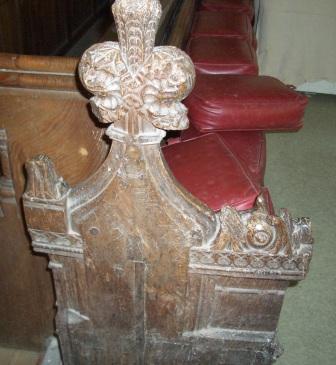
Bench end showing the remains of a carving of the wolf with St Edmund's head.
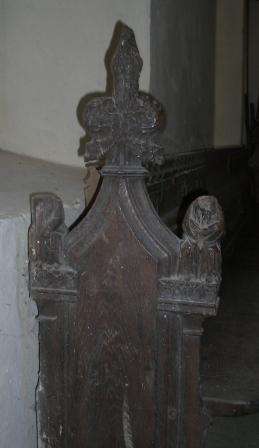
Another bench end showing more damage done by Dowsing and his team.
Church Fittings and Possessions
Bells
In 1626 a gift of money was received from Sir John Prescott via William Barker for the fourth bell to be taken to Thetford for repair.
In a terrier of 1723 it was noted that there were six bells with their frames.
William Gould, Clerk, Joseph Chilver and James Clubb, Churchwardens, applied for a faculty.
'It has been represented unto us that the Parish Church of Hoxne is greatly decayed and out of repair, and the burden of effectually repairing the same will be too great for the parishioners'In 1744 permission was granted to sell one bell, which was believed to be split, to help meet the cost.
A terrier of 1845 states that:
At the present time there are five bells in the tower, two of which are much older than the others.The inscriptions are as follows:-
1. 'John Darbie (of Ipswich) made me. 1676.' This bell was appartently bought from Thorpe Abbotts.
2. 'Every sound paises The Lord' - The arms of the Thruston family are engraved on this bell, which was recast in 1655
3. 'In this concave, Gabriel unites us sweetly.' 'John Goldsmith made me 1711'
Numbers 4 and 5 are the oldest and bear the following inscriptions:-
4. 'Pray for the sone of Richard Smith.' 'By the merits of Thomas may we meet the joys of light.'
5. 'Make O Margaret, these duties delightful to us.'
In the Diss Express, of the 4th March 1870, the following was reported:-
CHANGE RINGING. - On Monday evening a company of ringers ascended the fine tower of St. Peter's Church, and rung in good style 1870 changes in one hour and five minutes. The following were the peals rung: Bob Doubles, Dunston Doubles, Morning Star, Fortune and the Dream. The ringers were:Mr. Samuel Shimmin, treble; Mr. Johnson Hern, 2nd; Mr Charles Rudd, 3rd; Mr John Elsey, 4th; Mr Joel Hern, tenor and conductor. Weight of tenor 15 cwt. These bells were formerly a peal of six, but the tenor being split, it was sent to be recast, and never restored. It is hoped means will be taken to procure another bell, as this would then be one of the finest peals of six in the county.
In May 1875 the Church bells were re-hung after repairs to the bell-frame. Messr. Geo. Day and Son, Church Bell Hangers of Eye, restored the bell-frame with new oak timbers provided by Sir Edward Kerrison.
In April 1887, George Day was paid £3 5s. for repairing the bells.
In a report of a 'Choir Supper' in the Diss Express of 21st February 1947 it was recorded that:-
Somewhere about 1740 the tenor bell in Hoxne Parish Church was taken to Eye Parish Church in payment of a debt, it is believed.The then current vicar (the Reverend William H. Groom) wanted to see the full peal of six bells restored and therefore a fund was set aside for this purpose.
It seems that the story of the fate of the sixth bell has varied over the years!
The last time the bells were rung was in 1964. Their condition and that of the frames has prevented their use since although it is hoped that they will be restored in the future.
Lamps
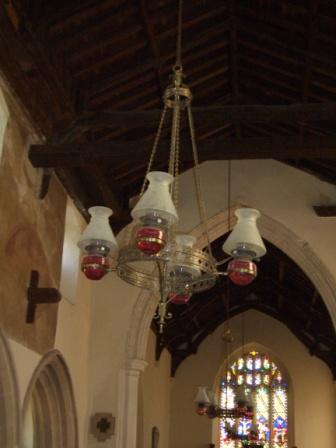
In March 1887 the old lamps in the Church were replaced by 4 new ones, three in the nave and one in the chancel. They were of polished brass with ruby coloured reservoirs and pyramid shaped shades. They were supplied by Messr. Jones and Willis of London. There were also 5 new single pendant lights in the north aisle. The total cost of the lamps was about £50.
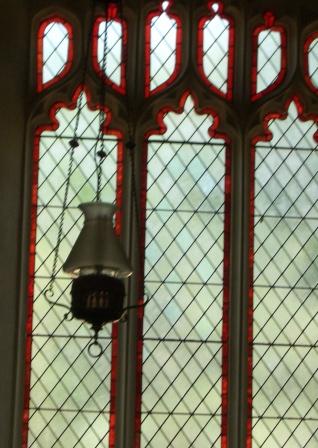
A brass plaque was to be placed on the south wall under the tablet recording the births and deaths of Sir Edward Kerrison and his son, bearing the inscription:
'To the Glory of God, and in loving memory of the late Sir Edward Kerrison, these lamps were placed in this church by the parishioners of Hoxne, in March 1887'
Chests
In the church is a large iron bound chest about 9 feet long with 7 locks. It has been dated to about 1370. It is described in an old manuscript in the Britsh Museum as 'standing in the vestry, of oak, covered with plates of iron and having a great many iron bars and locks. Amongst the curiosities remaining in it in 1712 were a vey large hour glass, and an old folio called 'Tractatus de Tempore', left by Bishop Goldwell about 1450 to descend from vicar to vicar. The church plate in the year 1694 consisted of one 'bigge patene for ye brede' written 'ye gift of my Lady Chauncy', also 'two lesser patene', and a flagon of pewtere.'
The origin of Church chests appears to be about 1251 when the country was overrun with foreign moneylenders who treated their clients very harshly. To prevent this many villages gathered together a sum of money and made loans to the villagers, without interest, either upon the security of a pledge or the word of three sureties. The capital sum was kept in the Church chest, in the case of Hoxne, with seven locks, one key being held by each of the seven trustees. The loans were made for one year only and if defaulted the pledge was sold and any profit returned to the borrower.
In about 1862 the Rev. French of Worlingworth, with the permission of the Rev. Hodgson of Hoxne, removed the chest to Worlingworth to restore it (some say the Rev Hodgson sold it!). However it was returned to Hoxne by the kindness of the Rector of Worlingworth and the efforts of the Hon. Charles Bateman Hanbury in 1900. The locks were restored by Mrs Hill-Wood of Oakley Park.
Plate and vestments etc.
In his will of 1522 Stephen Lacy of Hoxne bequeathed '10 marks to buy a payer of silver candlesticks for the High Altar in Hoxne Church'
From Hoxne and South Elmham Visitation Book entry for 1686
Hoxne: Ed. Willan Vicar
Wm. Jasper. Andrew Foulger. (Churchwardens)
To provide the 39 Articles and Book of Canons.
In 1694, the Vicar, Francis Hutchinson lists in his account book the plate belonging to Hoxne Church as follows:
One large Paten for the bread inscribed 'The gift of my Lady Chauncy', two lesser silver patens and a pewter flagon.
Lady Elizabeth Chauncy was the wife of Sir Henry Chauncy and daughter of Nathaniel Thruston of Hoxne abbey.
In a Terrier of 1723 the following items were recorded:-
1 Pewter Flaggon
1 Silver Chalice
1 Large Silver Patin
2 smaller Patin, silver
1 Green Cloth for the Communion Table
1 Pulpit Cloth and cushion for the same
1 fine Linen Cloth and 2 Napkins for the Communion Table
1 large Surplice of Holland
2 Common Prayer Books
1 large Bible of the last translation
1 Book of Homilies
1 Book of Sermons given by Bishop Goldwell in 1498
Bishop Jewel's Works
A Defence of the Apology for the Church of England [purchased in 1578]
It also mentions the 6 bells in their frames and 1 Town Clock
Between the 2nd and 3rd of November 1777 Hoxne Church was broken into and the chest in the vestry forced open. The church plate was stolen, including one cup, one salver and two patens. Published in the Ipswich Journal, a reward of 20 guineas was offered by the Churchwardens, Jeffery Pearl and Robert Roper, for the discovery of the thieves.
The Town Land Trust Accounts accounts record, in 1791:
'Paid for ye Communion Plate £27 6/6'This included a large flagon, a chalice and a large paten.
In the Terrier of 1813 it is recorded that 4 pieces of Communion Plate were purchased.
By 1845 the Town Clock was declared entirely useless and incapable of being repaired. The Terrier also records that 'Bishop Goldwell's Sermons, the Book of Homilies, A Defence of the Apology for the Church of England and the Works of Bishop Jewell' can no longer be found.
To help fund church repairs in 1858 an 'old worn out Sacremental Cup' was sold for £1 11s and an 'old Pewter Tankard' was sold for 1s 2d.
In an inventory of Church Plate by Edmund Charles Hopper, in 1893, the plate in Hoxne Church was record as being: a cup and flagon with no inscription and two patens each inscribed 'Parish of Hoxne, Suffolk 1791'. Each of these four pieces marked with the leopard's head, crowned, the lion passant, a date letter for 1790 and maker's mark 'S.G.E.W.'. There was a second cup marked with the leopard's head, the lion passant, the queen's head, a date letter for 1843 and maker's mark 'C.T.F' over 'G.F.'.
Jubilee Clock
In 1887 the Parish of Hoxne wished to do something to observe the Queen's Jublilee. The two posibilities considered were a Jubilee Clock for the Church tower or a general feast and associated festivities and a Committee was formed to determine the result. The whole Parish was canvassed asking for a promised subscription to the clock or the feast. The result was that 146 subscribers promised £87 5s. 8d. for the clock and 87 subscribers promised £86 10s. 6d. for the feast. The estimated cost of the clock and installation was £100 and the Committee agreed to guarantee any amount above that which had been promised.
As there had also been a lot of support for a feast it was decided that one should be held on Jubilee Day, the 21st June. It was suggested that in addition to any subscriptions each man and his wife should pay 1s. 6., and every person over 16 years 1s. towards the dinner. In addition, the farmers agreed to give their men a days holiday, without stopping their pay, although it was suggested that the men contributed this days wage to the fund!
Organ
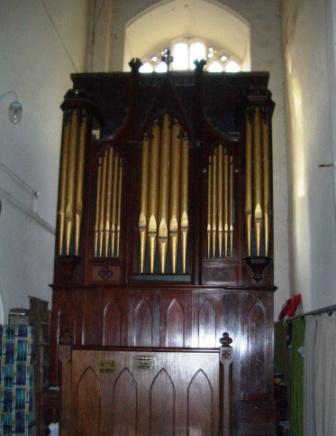
In 1836 Sir Edward Kerrison presented an organ to the Church reputed to have cost 200 guineas built by the London firm of J. W. Walker and Son.
In 1867 it was rebuilt, converted into a finger organ and moved into the Maynard Chapel on the north side of the Chancel.
In April 1887, Norman Bros. were paid £3 for 2 years tuning of the organ according to the Churchwardens accounts.
The inscription on the organ reads:
'Originally a barrel organ this instrument was presented to Hoxne Church in 1836 by General Sir Edward Kerrison, Bart. K.C.B.. In 1867 his son Sir E. C. Kerrison Bart., had it converted into a single manual organ and, in 1906, as a memorial to the Gereral's grandson, the Hon. Walter Bateman Hanbury, the organ was rebuilt, a swell organ added and the pedals extended to full compass'
In 1906 a further inscription was added at the end facing the congregation:-
'To the Glory of God and in the memory of the Honble. Walter Bateman-Hanbury, who died at Brome Hall, 21st Feb. 1904, 3rd son of William, second Baron Bateman and Agnes, his wife, this organ was entirely rebuilt and extensively enlarged by his surviving brothers and sisters:
W. Spencer, 3rd Baron Bateman
Maud F. Parker
Evelyn A. Foster
Edwd. R. Bateman-Hanbury
Gertrude E. Wood
A. Rosamund Bateman-Hanbury
M. Celcilia Hovell
R. A. S. Decima Hill Wood
Chas. S. M. Bateman-Hanbury
Easter, 1906.'
When the organ was rebuilt by Messrs. J. W. Walker and Sons of London, in 1906, an opening recital was given by Sir Walter Alcock, organist of Salisbury Cathedral.
An electric blower for the organ was given to both Hoxne and Denham Churches by Noel Mander who completed a restoration of the organ at St. Paul's Cathedral.(1970's?)
Further restoration was carried out by the Ipswich firm of organ builders, Bishop and Son, in 2003. A plaque marking the restoration reads 'Dr. Christopher David Bjorn Daniel 1958 - 2000'. It was restored in his memory.
Gallery
At the west end of the Church there was a gallery erected at the charge of Mr Maynard and Col. Thruston. The Font is underneath the gallery.
A licence was granted by Bishop John Moore on 21st October 1700 to erect a gallery in the tower 'desirous to encourage and promote decent ornamenting of the church'.
This is a direct reference to a 'West Gallery' (at the opposite end of the church to the altar) where the choir and local instrumentalists would sit in splendid isolation to accompany the hymns, chants, Psalms and Canticles. When the time came for music to be played the congregation would stand and turn with their backs to the altar to 'face the music'. This is where that phrase originated.
In the churchwardens accounts for 1700 is list of timber, some brought from Norwich, and materials necessary for erecting the gallery, which, including the wages of the workmen cost £28 13s.7d. to put up.
There is also a list of persons who subscribed towards this and in this way £18 6s. was raised. The following is a list of subscribers:
| Subscriber | £ | s. | d. |
|---|---|---|---|
| Lord Maynard | 5 | 0 | 0 |
| Colonel Thruston | 5 | 0 | 0 |
| Dr. Hutchinson | 2 | 0 | 0 |
| Mr Beeston | 0 | 10 | 0 |
| Mr Leman | 0 | 10 | 0 |
| Mr Godward | 0 | 10 | 0 |
| William Jasper | 0 | 10 | 0 |
| John Wilton | 0 | 10 | 0 |
| Thomas Craeme | 0 | 10 | 0 |
| Mr Pennyng | 0 | 5 | 0 |
| Mr Miller | 0 | 5 | 0 |
| Mrs Barker | 0 | 2 | 6 |
| Samuel Chilvers | 0 | 5 | 0 |
| Thomas Jasper | 0 | 5 | 0 |
| Ch. Pumstead | 0 | 2 | 0 |
| John Ellis | 0 | 1 | 0 |
| Thomas Press | 0 | 5 | 0 |
| J. Harrison | 0 | 2 | 6 |
| John Roper Snr. | 0 | 3 | 0 |
| John Roper Junr. | 0 | 3 | 0 |
| Daniel Stebbing | 0 | 4 | 6 |
| Thomas Cunningham | 0 | 1 | 6 |
| John Baxter | 0 | 2 | 0 |
| Robert Vats | 0 | 0 | 6 |
| The Widow Welton | 0 | 2 | 6 |
| John Powell | 0 | 2 | 6 |
| Thomas Stebbing | 0 | 4 | 6 |
| Denis Cantor | 0 | 1 | 0 |
| John Welton Junr. | 0 | 2 | 6 |
| Robert Welton | 0 | 2 | 6 |
| S. Chilvers Junr. | 0 | 1 | 0 |
| John Marsh | 0 | 1 | 0 |
| John Newstead | 0 | 1 | 0 |
